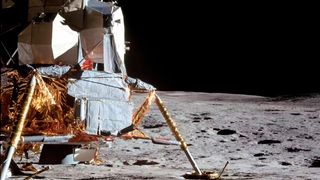Scientists have used AI to discover an easier method to form quantum entanglement between subatomic particles, paving the way for simpler quantum technologies. When particles such as photons become entangled, they can share quantum properties — including information — regardless of the distance between them. This phenomenon is important in quantum physics and is one of the features that makes quantum computers so powerful. But the bonds of quantum entanglement have typically proven challenging for scientists to form. This is because it requires the preparation of two separate entangled pairs,…
Read MoreCategory: The Moon
Our moon
Property and sovereignty in space: Countries and companies face potential clashes as they take to the stars
This article was originally published at The Conversation. The publication contributed the article to Space.com’s Expert Voices: Op-Ed & Insights. Wayne N White Jr consults with One Space Technologies Inc. He is a member and former Director of The National Space Society and an Associate Fellow of AIAA. Private citizens and companies may one day begin to permanently settle outer space and celestial bodies. But if we don’t enact governing laws in the meantime, space settlers may face legal chaos. Many wars on Earth start over territorial disputes. In order…
Read MoreIs there life out there? The existence of other technological species is highly likely
We live in a golden age for space exploration. Scientists are gathering massive amounts of new information and scientific evidence at a record pace. Yet the age-old question remains unanswered: are we alone? New telescope technologies, including space-based tools such as the James Webb Telescope, have enabled us to discover thousands of potentially habitable exoplanets that could support life similar to that on Earth. Gravitational wave detectors have opened a new avenue for space exploration by detecting space-time distortions caused by black holes and supernovae millions of light-years away. Commercial…
Read MoreHere’s the launch plan for NASA’s SPHEREx and PUNCH missions: ‘Liftoff is just the beginning’
After more than a week of delays, two new NASA missions have been cleared for liftoff tonight (March 8). The space agency’s SPHEREx and PUNCH missions, which are sharing a ride aboard the SpaceX Falcon 9 rocket, are scheduled to lift off no earlier than 10:09 p.m. EST (7:09 p.m. PST) tonight from Launch Complex 4E at Vandenberg Space Force Base in California. The launch, postponed six times over the past week due to technical issues and bad weather, was given the greenlight after a successful launch readiness review on…
Read MoreThis Week In Space podcast: Episode 151 — In Search of Alien Megastructures
In Search of Alien Megastructures – With Former NASA Chief Scientist, Dr. Jim Green – YouTube Watch On On Episode 151 of This Week In Space, Rod Pyle and Tariq Malik talk with former NASA Chief Scientist Jim Green about how we can search for technosignatures that might indicate advanced civilizations in other star systems, new ideas on Mars sample return, and his fascinating experience consulting on the movie, “The Martian!” Also: this week’s robotic landings on the Moon — one successful, one partly so; what’s up with the USAF…
Read MoreNew ‘Starman’ documentary shines light on NASA JPL legend Gentry Lee
Gentry Lee, the certified Hall of Famer engineer from NASA’s Jet Propulsion Laboratory and distinguished science fiction author, is getting his time in the spotlight in a new documentary on his life launching at the SXSW 2025 Film Festival in Austin this weekend. Written and directed by award-winning filmmaker Robert Stone, “Starman” is an 85-minute exploration of Lee’s experience working in the arena of interplanetary exploration as the Chief Engineer for the Solar System Exploration Directorate at the Jet Propulsion Laboratory in Pasadena, California, and we’ve got an exclusive clip…
Read MoreFor NASA astronauts on a 10-day space mission that lasted 9 months, a landing date at last
Two NASA astronauts who launched on a short mission to the International Space Station last year that turned into a 9-month marathon finally know when they’ll be coming home. The Boeing Starliner astronauts, who launched on the spacecraft’s Crewed Flight Test on June 5, have been living aboard the International Space Station (ISS) ever since after their capsule returned to Earth without them. On Friday (March 7), NASA cleared a relief crew to launch on SpaceX Dragon next week, setting the stage for their long-awaited return to Earth. NASA astronauts…
Read MoreFAA investigating SpaceX Starship Flight 8 explosion that disrupted commercial flights
SpaceX’s latest Starship to attempt to reach space exploded nine minutes after its launch this week, leaving a trail of debris in its wake. Airports in Florida were forced to halt flights as the threat from impacts extended south to the Bahamas and Turks and Caicos Islands. Now the Federal Aviation Administration (FAA) is again requiring SpaceX to perform a mishap investigation into what led its eighth Starship test flight to end with a loss of the vehicle. The rocket launched toward space Thursday (March 7) from SpaceX’s Starbase facility…
Read MoreScientists discover Earth’s oldest impact crater in Australia
Geologists have discovered the world’s oldest known impact crater; it sits in the heart of Western Australia’s ancient Pilbara region. An analysis of rock layers in the region suggests a crater at least 62 miles (100 kilometers) wide was carved after a large space rock struck Earth roughly 3.47 billion years ago, when our planet was almost completely covered in water. The discovery pushes back the record for the oldest impact crater on Earth by more than 1 billion years — the previous record holder, the Yarrabubba impact structure, also…
Read MoreWatch fiery SpaceX Starship Flight 8 debris rain down over The Bahamas (video)
Starship put on a show for skywatchers yet again — but not the way that SpaceX would have liked. SpaceX launched the eighth test flight of Starship, the biggest and most powerful rocket ever built, from its Starbase site in South Texas on Thursday evening (March 6). Starship‘s huge first-stage booster, known as Super Heavy, came back to Starbase for a launch-tower catch about seven minutes after liftoff as planned. But the vehicle’s 171-foot-tall (52 meters) upper stage — called Starship or just Ship — experienced a serious problem shortly…
Read More








